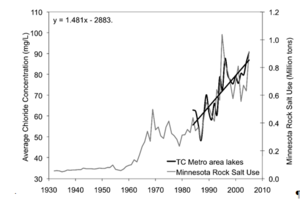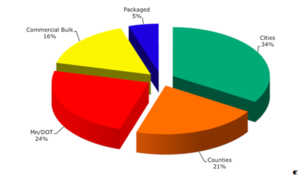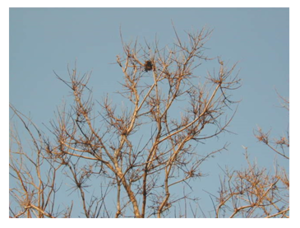
Background information for winter parking lot and sidewalk maintenance
We are in the process of migrating the Winter Parking Lot and Sidewalk Maintenance manual to the Minnesota Stormwater Manual. This page is undergoing review. You can access a pdf version of the maintenance manual here. Other changes and updates to information on salt management will be posted in the What's new page in the manual. Information on road salt and water quality can be found on MPCA's website
The purpose of this manual is to deliver practical advice to those managing parking lots and sidewalks. This manual will help to make proactive, cost-effective, environmentally conscious choices in winter parking lot and sidewalk management. This knowledge will provide the opportunity to become a leader in the industry by operating more efficiently and reducing environmental impacts.
A single approach will not work for the range of conditions Minnesota experiences; different strategies are needed for different regions and different weather conditions. We encourage continuing to test, document, and refine the practices from this manual.
Making good business choices
Customer service is the key to success. Best Management Practices (BMP) keep parking lots and sidewalks safe and also reduce environmental impacts. Educating customers on the proper methods of snow removal and ice control (and of the value of this approach) can create a good and long-standing relationship.
Customers want reliable service. Providing a well-planned and well-executed winter maintenance program will have a positive impact. Using the latest technologies will increase the ability to provide reliable service.
Customers want to hire educated winter maintenance professionals. This manual will provide the necessary information to increase staff knowledge on the best practices for winter maintenance.
Customers and the public want safe parking lots and sidewalks. Understanding the materials, weather and application rates, provide a head start on controlling icy, slippery parking lots, and sidewalks.
Clean and neat parking lots and sidewalks are important to the public. By using less material and increased winter sweeping, pedestrians will track less material into buildings and there will be less damage to flooring. Proper snow storage makes debris removal in the spring easier. Covered storage of deicers will reduce loss of material, protect water, and is more aesthetic. Using BMPs and lower application rates will keep parking lots and sidewalks looking neat.
Customers also want affordable snow and ice control. The use of sophisticated chemicals and equipment may require a larger budget up-front; however, these costs can be balanced by reduced on-going costs. Reducing the need for sweeping, floor and rug maintenance, parking lot striping, and snow and ice maintenance time will allow for cost savings.
Minnesotan’s value water resources and the protection of lakes, streams, and wetlands is important. Educating customers how sustainable winter maintenance protects water resources is necessary.
Water and environmental impacts
Only 2.5 percent of all of the water on this planet is freshwater (not saltwater). Of that, less than 1 percent is available for use, with the majority of the freshwater frozen in ice (Freshwater Crisis n.d.). There is a limited supply of water on this planet and that water is reused, recycled and dispersed, often over long periods of time (Healthy Rivers, 2004).
Because the supply of water can be limiting, it is important to keep it clean. Once polluted, water may become unusable or require cleanup. Elevated concentrations of chloride can diminish the quality of water. Chloride concentrations are increasing in many surface waters and in shallow groundwater across Minnesota.
- In the Twin Cities Metropolitan Area (TCMA), of surface water bodies tested, 39 are on the draft 2014 impaired waters list for chloride exceedances and 38 more are found to be at high risk as of July 2015. (MPCA 2015). Salts (chloride) dissolve in water and move with the water to nearby lakes, streams, and wetlands and also infiltrate into groundwater.
- Chloride does not degrade and cannot be removed from surface waters. It moves with water and can eventually flush out of a water system, but if chloride inputs exceed outputs chloride will accumulate in the environment over time.
- Salt water is heavier than freshwater and may sink to the bottom of lakes. This may cause chemical stratification of the lake and loss of or changes in lake turn over (Stefan et al. 2008).
- Thirty percent of the 270 shallow aquifer monitoring wells tested in the TCMA exceeded the Secondary Maximum Contaminant Level of 250 milligrams per liter (MPCA 2013).
- About 75 percent of Minnesotans rely on groundwater for drinking water. If chloride-enriched water moves from shallow to deeper aquifers, the salt contamination could penetrate sources of drinking water (MPCA 2013).
- The average salt use in the TCMA based on purchasing records is 349,000 tons per year (Sander et al. 2007).
Deicers can be very damaging to both soil and vegetation. Efforts to keep salt off vegetation are needed. Examples include driving slower when applying deicers, turning down spinner speeds to reduce spread pattern, using drop spreaders on sidewalks, storing snow piles on hard surfaces, and reducing application rates. One source of information about salt-tolerant plants is the Plant Selector from Minnesota Department of Transportation.
Related pages
- Background information for winter parking lot and sidewalk maintenance
- Preparing for winter operations for winter parking lot and sidewalk maintenance
- Keeping surfaces clear for winter parking lot and sidewalk maintenance
- Evaluating the effectiveness for winter parking lot and sidewalk maintenance
- Environmental tips for winter parking lot and sidewalk maintenance
- Cost savings tips for winter parking lot and sidewalk maintenance
- Results and evaluation for winter parking lot and sidewalk maintenance
- Material conversions for winter parking lot and sidewalk maintenance
- References for winter parking lot and sidewalk maintenance
- Additional resources and links to websites for winter parking lot and sidewalk maintenance


